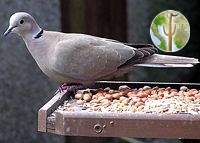Non-natives - Sahara mustard (Brassica tournefortii) and Eurasian collared dove
 Buffelgrass has become well known as an invasive exotic species, but many other dangerous exotics threaten parts of the southwest and have garnered much less attention. One in particular comes to mind from my experiences: Sahara mustard (Brassica tournefortii). This mustard has an affinity for sandy or bottomland soil in the middle and especially lower elevation Sonoran Desert. It has spread rapidly across large areas of southwestern Arizona and southeastern California. I've recently seen it in several disturbing places including the Pinacate Biosphere Reserve, in Bear Canyon in the Catalinas, and Saguaro National Park (east and west!). The Arizona/Sonora Desert Museum has a good webpage on this mustard. Jan Emming has put together an extensive primer on Sahara Mustard.
Buffelgrass has become well known as an invasive exotic species, but many other dangerous exotics threaten parts of the southwest and have garnered much less attention. One in particular comes to mind from my experiences: Sahara mustard (Brassica tournefortii). This mustard has an affinity for sandy or bottomland soil in the middle and especially lower elevation Sonoran Desert. It has spread rapidly across large areas of southwestern Arizona and southeastern California. I've recently seen it in several disturbing places including the Pinacate Biosphere Reserve, in Bear Canyon in the Catalinas, and Saguaro National Park (east and west!). The Arizona/Sonora Desert Museum has a good webpage on this mustard. Jan Emming has put together an extensive primer on Sahara Mustard.
This mustard is incredibly tenacious and out-competes nearly everything including other annuals. Some places in southwestern Arizona it can cover vast areas in a near monoculture.
Another species we all should be keeping our eye on is the Eurasian collared dove, which appears to be becoming much more common in Arizona and Sonora in recent years. It is primarily found so far in human settlements, but not exclusively. It may start displacing native doves such as the white-winged dove and mourning dove, among others. 2010 and 2011 seem to be a boom year for the Eurasian collared dove in Tucson and parts of Sonora. I now spot this dove daily in Tucson.
